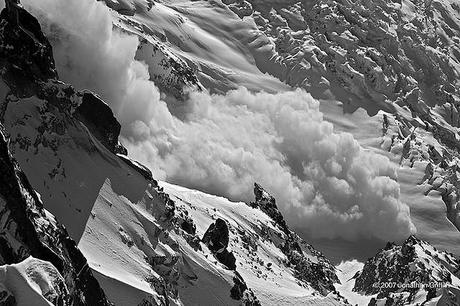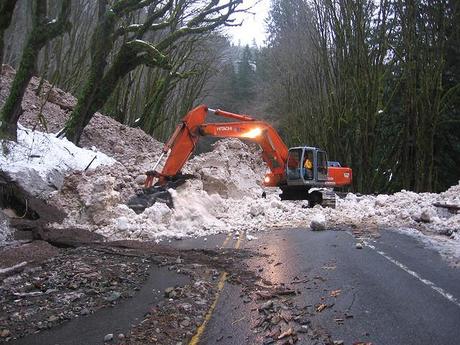What is an Avalanche?
Spending winters in the mountains with nothing but white snow on all sides can be quite relaxing. For those wanting an adrenaline rush, the snow is a great place to go skiing, snowboarding and even having snowball fights. However, being on the slopes means one has to constantly be alert if they don’t want to get caught in an avalanche. The rapid descent of snow may seem harmless, but it can cause a lot of damage to life and property. This is why understanding of avalanches is necessary for those fond of spending their luxury time in the mountains.
On any slope, the snow is piled up and supported by a snow-pack. It keeps the snow from tumbling down all the time. Avalanches occur when the snow-pack starts to weaken and allows the buildup of snow to be released. Small avalanches are generally made up of ice, snow and air. The larger ones comprise of rocks, trees, debris and even mud that is resting on the lower slopes. Contrary to belief, these snow slides are not random events that occur without any warning signs. Winter season is when they are most common, often brought on after a large storm in the area. Rainfall and sleet also tend to be responsible for avalanches in the summer and monsoon season.

4 Types of Avalanches
To help in understanding of avalanches, they have been classified into four types.
1. Loose Snow Avalanches: First of these are the Loose Snow Avalanches. They are common on steep slopes and are seen after a fresh snowfall. Since the snow does not have time to settle down fully or has been made loose by sunlight, the snow-pack is not very solid. Such avalanches have a single point of origin, from where they widen as they travel down the slope.
2. Slab Avalanches: Loose Snow Avalanches in turn could cause a Slab Avalanche, which are characterized by a the fall of a large block of ice down the slopes. Thin slabs cause fairly small amounts of damage, while the thick ones are responsible for many fatalities.
3. Powder Snow Avalanches: Powder Snow Avalanches are a mix of the other forms, Loose Snow and Slab. The bottom half of this avalanche consists of a slab or a dense concentration of snow, ice and air. Above this is a cloud of powdered snow, which can snowball into a larger avalanche as it progresses down the slope. The speed attained by this avalanche can cross 190 miles per hour and they can cross large distances.
4. Wet Snow Avalanches: Finally, there are Wet Snow Avalanches. These are quite dangerous as they travel slowly due to friction, which collects debris from the path fairly easily. The avalanche comprises of water and snow at the beginning, but understanding of avalanches has showed us that it can pick up speed with ease.
Causes of Avalanches
There is no one reason behind the development of avalanches. It was believed for long that the echo of a human voice in the mountains could dislodge enough snow to start one. Similarly, a person’s weight can cause a avalanche too. The sudden addition of weight can fracture a weak area of snow. However, scientific understanding of avalanches shows us that there are many environmental factors at work.
1. Snowstorm and Wind Direction: Heavy snowstorms are more likely to cause Avalanches. The 24 hours after a storm are considered to be the most critical. Wind normally blows from one side of the slope of mountain to another side. While blowing up, it will scour snow off the surface which can overhang a mountain.
2. Heavy snowfall: Heavy snowfall is the first, since it deposits snow in unstable areas and puts pressure on the snow-pack. Precipitation during the summer months is the leading cause of wet snow avalanches.
3. Human Activity: Humans have contributed to the start of many avalanches in recent years. Winter sports that require steep slopes often put pressure on the snow-pack which it cannot deal. Combined with the heavy deforestation and soil erosion in mountain regions, it gives the snow little stability in the winter months. Further natural causes include earthquakes and tremors, since they can often create cracks in the snow-pack.
4. Vibration or Movement: The use of All Terrain Vehicles and Snowmobiles creates vibrations within the snow that it cannot withstand. Coupled with the gravitational pull, it is one of the quickest ways to cause an avalanche. The other is construction work done with explosives, which tend to weaken the entire surrounding area.

5. Layers of Snow: There are conditions where snow is already on the mountains and has turned into ice. Then, fresh snow falls on top which can easily slide down.
6. Steep Slopes: Layers of snow build up and and slide down the mountain at a faster rate as steep slopes can increase the speed of snow. A rock or piece of huge ice can shake the snow and cause it to come down.
7. Warm Temperature: Warm temperatures that can last several hours a day can weaken some of the upper layers of snow and cause it to slide down.
Effects of Avalanches
As such, there is little damage to the overall ecological system due to avalanches. They are a part of nature and have been happening for thousands of years. However, they are a major natural hazard for the local human population.
1. Damage to Life and Property: A large number of casualties takes place after avalanches hit heavily populated areas. Infrastructure is damaged and the blockage caused, impacts the livelihood of many. People who enjoy skiing, snowboarding and snowmobiling are at a greater risk of losing their lives. A powerful avalanche can even destroy buildings and power supplies can be cut off.
2. Flash floods: When an avalanche occurs, it brings down all the debris with it and can cause havoc in low lying areas. Flash floods are seen to happen after avalanches, which is a long term problem many villagers and townspeople have to deal with. They can also change weather patterns and cause crop failure in farms present on the lower fields.
3. Economic Impact: An avalanche can block anything in its path and even restrict the normal movement of traffic. Various ski resorts depend on tourists to run their business successfully. Ski resorts and other businesses are forced to close until the avalanche decreases and weather conditions become suitable.
Image credit: Jonathan Griffith , WSDOT
References:
http://science.howstuffworks.com/nature/natural-disasters/avalanche.htm
http://environment.nationalgeographic.com/environment/natural-disasters/avalanche-profile/

